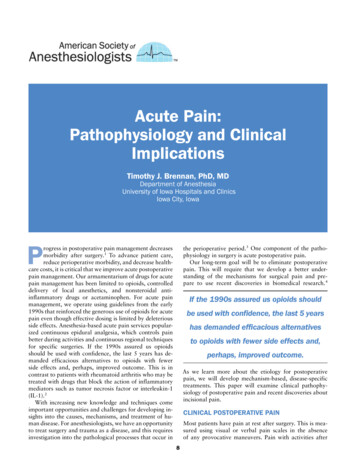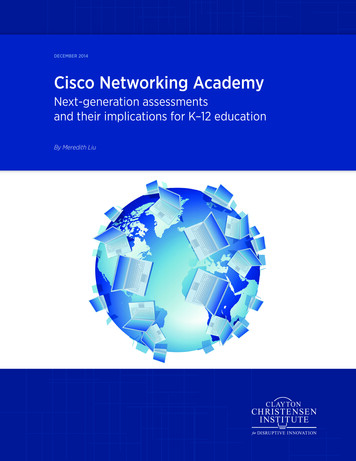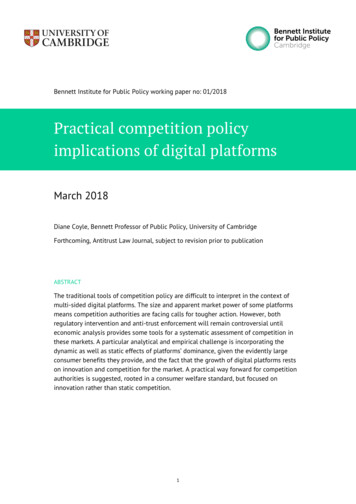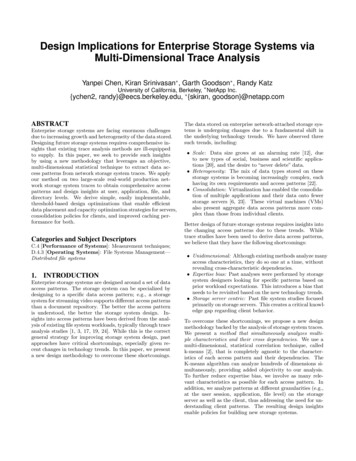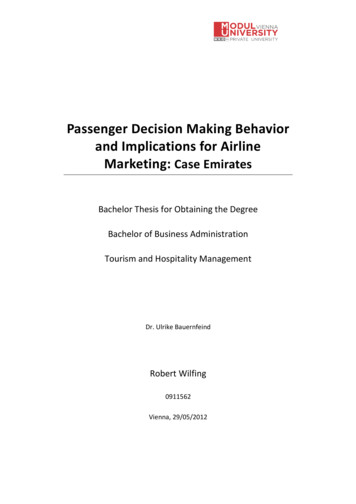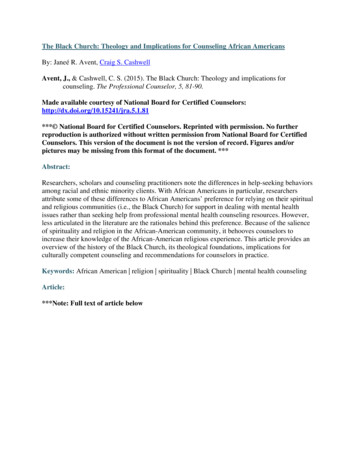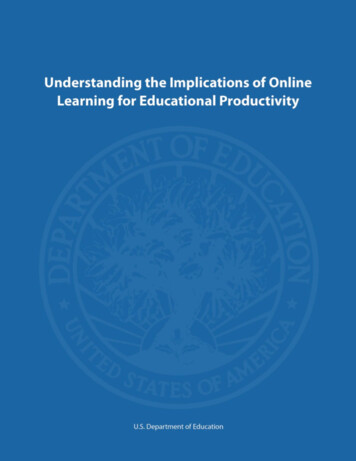
Transcription
Understanding the Implications of Online Learningfor Educational ProductivityU.S. Department of EducationOffice of Educational TechnologyPrepared by:Marianne BakiaLinda ShearYukie ToyamaAustin LasseterCenter for Technology in LearningSRI InternationalJanuary 2012
This report was prepared for the U.S. Department of Education under Contract number ED01-CO-0040 Task 0010 with SRI International. The views expressed herein do notnecessarily represent the positions or policies of the Department of Education. No officialendorsement by the U.S. Department of Education is intended or should be inferred.U.S. Department of EducationArne DuncanSecretaryOffice of Educational TechnologyKaren CatorDirectorJanuary 2012This report is in the public domain. Authorization to reproduce this report in whole or in partis granted. While permission to reprint this publication is not necessary, the suggested citationis: U.S. Department of Education, Office of Educational Technology, Understanding theImplications of Online Learning for Educational Productivity, Washington, D.C., 2012.This report is available on the Department’s Web site at http://www.ed.gov/technologyOn request, this publication is available in alternate formats, such as Braille, large print, or computerdiskette. For more information, please contact the Department’s Alternate Format Center at (202)260-0852 or (202) 260-0818.Technical Contact:Bernadette AdamsSenior Policy AnalystOffice of Educational Technologybernadette.adams@ed.gov
ContentsExhibits . iiAcknowledgements . iiiExecutive Summary . vIntroduction. 1Overview of Online Learning for Secondary Education . 1Purpose of this Report . 3Introduction to the Measurement of Educational Productivity . 5Estimating Program Costs . 8Documenting Context and Implementation . 10Measuring Program Outcomes . 10Cost-Effectiveness Research Requirements . 12The Productivity Potential of Online Learning . 15Opportunities to Reduce Educational Costs Through Online Learning . 25Implications . 33The Need for Transformation . 34Suggestions for Future Research . 35Appendix A: Additional Resources . A-1General Productivity in Education . A-2Productivity and Educational Technology. A-3Key Resources on Types and Prevalence of Online Learning. A-13Quality Standards for Online Learning Programs . A-15References . A-17i
ExhibitsExhibit 1: Components of Educational Productivity Analyses . 7Exhibit 2: Comparison of Per-Pupil Spending . 26ii
AcknowledgementsThis issue brief was developed under the guidance of Karen Cator and Bernadette AdamsYates of the U.S. Department of Education, Office of Educational Technology.At SRI International, Marie Bienkowski, Barbara Means and Robert Murphy providedadvice and insightful feedback on earlier drafts of the report. Ashley Lee and Allison Steeleprovided research assistance. The report was edited by Michael Smith. Kate Borelliproduced graphics and layout.The authors made their best attempt to incorporate the thoughtful guidance provided byreviewers of earlier drafts of this report, including Cathy Cavanaugh (University of Florida),Fiona Hollands (Teachers College, Columbia University), Kemi Jona (NorthwesternUniversity), Glenn Kleiman (Friday Institute for Educational Innovation), Robin Lake(University of Washington) and Henry Levin (Teachers College, Columbia University). Theauthors are grateful for their constructive comments.iii
iv
Executive SummaryEducational systems are under increasing pressure to reduce costs while maintaining orimproving outcomes for students. To improve educational productivity, 1 many schooldistricts and states are turning to online learning.In the United States, online learning alternatives are proliferating rapidly. Recent estimatessuggest that 1.5 million elementary and secondary students participated in some form ofonline learning in 2010 (Wicks 2010). The term online learning can be used to refer to awide range of programs that use the Internet to provide instructional materials and facilitateinteractions between teachers and students and in some cases among students as well.Online learning can be fully online, with all instruction taking place through the Internet, oronline elements can be combined with face-to-face interactions in what is known as blendedlearning (Horn and Staker 2010).The purpose of this report is to support educational administrators and policymakers inbecoming informed consumers of information about online learning and its potential impacton educational productivity. The report provides foundational knowledge needed to examineand understand the potential contributions of online learning to educational productivity,including a conceptual framework for understanding the necessary components of rigorousproductivity analyses, drawing in particular on cost-effectiveness analysis as an accessiblemethod in education. Five requirements for rigorous cost-effectiveness studies are described:1) Important design components of an intervention are specified;2) Both costs and outcomes are measured;1As defined in this report, productivity is a ratio between costs and outcomes that can be improved in one of three ways: byreducing costs while maintaining outcomes, improving outcomes while maintaining costs or transforming processes in away that both reduces costs and improves outcomes. Any improvements in productivity are likely to require initialinvestments, but successful efforts reduce costs over the long term, even after these initial investments are taken intoaccount.v
3) At least two conditions are compared;4) Costs and outcomes are related using a single ratio for each model under study;5) Other factors not related to the conditions being studied are controlled or heldconstant.The report also includes a review of ways that online learning might offer productivitybenefits compared with traditional place-based schooling. Unfortunately, a review of theavailable research that examined the impact of online learning on educational productivityfor secondary school students was found to be lacking. No analyses were found thatrigorously measured the productivity of an online learning system relative to place-basedinstruction in secondary schools. 2 This lack of evidence supports the call of the NationalEducational Technology Plan (U.S. Department of Education 2010a) for a national initiativeto develop an ongoing research agenda dedicated to improving productivity in the educationsector. The evidence summarized in this report draws on literature that addressed either costsor effectiveness. These studies typically were limited because they did not bring the twotogether in a productivity ratio and compare results with other alternatives.Given the limitations of the research regarding the costs and effects of online instruction forsecondary students, the review that follows also draws on examples and research about theuse of online learning for postsecondary instruction. While there are many differencesbetween higher education and elementary and secondary education (e.g., age and maturity ofstudents), postsecondary institutions have a broader and longer history with online learningthan elementary and secondary schools. The intention is to use the literature from highereducation to illustrate concepts that may apply to emerging practices in elementary andsecondary education. Findings from the studies of higher education should be applied withcaution to secondary education, as student populations, learning contexts and financialmodels are quite different across these levels of schooling.While rigorously researched models are lacking, the review of the available literaturesuggested nine applications of online learning that are seen as possible pathways toimproved productivity:2Two research reports—an audit for the Wisconsin State Legislature (Stuiber et al. 2010) and a study of the Florida VirtualSchool (Florida Tax Watch Center for Educational Performance and Accountability 2007)—include data about costs andeffects. These reports suggest that online learning environments may hold significant potential for increasing educationalproductivity. Both found that online learning environments produced better outcomes than face-to-face schools and at alower per-pupil cost than the state average. However, these conclusions must be viewed cautiously because both reportslacked statistical controls that could have ruled out other explanations of the findings.vi
1) Broadening access in ways that dramatically reduce the cost of providing access toquality educational resources and experiences, particularly for students in remotelocations or other situations where challenges such as low student enrollments makethe traditional school model impractical;2) Engaging students in active learning with instructional materials and access to awealth of resources that can facilitate the adoption of research-based principles andbest practices from the learning sciences, an application that might improve studentoutcomes without substantially increasing costs;3) Individualizing and differentiating instruction based on student performance ondiagnostic assessments and preferred pace of learning, thereby improving theefficiency with which students move through a learning progression;4) Personalizing learning by building on student interests, which can result inincreased student motivation, time on task and ultimately better learning outcomes;5) Making better use of teacher and student time by automating routine tasks andenabling teacher time to focus on high-value activities;6) Increasing the rate of student learning by increasing motivation and helpingstudents grasp concepts and demonstrate competency more efficiently;7) Reducing school-based facilities costs by leveraging home and community spacesin addition to traditional school buildings;8) Reducing salary costs by transferring some educational activities to computers, byincreasing teacher-student ratios or by otherwise redesigning processes that allow formore effective use of teacher time; and9) Realizing opportunities for economies of scale through reuse of materials and theirlarge-scale distribution.It is important to note that these pathways are not mutually exclusive, and interventionsintended to increase productivity usually involve multiple strategies to impact both thebenefit side (pathways 1–4) and cost side (pathways 5–9).Determining whether online learning is more or less cost-effective than other alternativesdoes not lend itself to a simple yes or no answer. Each of the nine pathways suggests avii
plausible strategy for improving educational productivity, but there is insufficient evidenceto draw any conclusions about their viability in secondary schools. Educational stakeholdersat every level need information regarding effective instructional strategies and methods forimproving educational productivity. Studies designed to inform educational decisions shouldfollow rigorous methodologies that account for a full range of costs, describe keyimplementation characteristics and use valid estimates of student learning.Even less is known about the impact of online learning for students with disabilities.Regarding potential benefits, the promise of individualized and personalized instructionsuggests an ability to tailor instruction to meet the needs of students with disabilities. Forexample, rich multimedia can be found on the Internet that would seem to offer readyinspiration for meeting the unique needs of the blind or the hearing impaired. In fact,standards for universal design are available both for the Web and for printed documents. Inaddition, tutorial models that rely on independent study are well suited to students withmedical or other disabilities that prevent them from attending brick-and-mortar schools.However, while online learning offerings should be made accessible to students withdisabilities, doing so is not necessarily cheap or easy.Any requirement to use a technology, including an online learning program, that isinaccessible to individuals with dis
Understanding the Implications of Online Learning for Educational Productivity . U.S. Department of Education . Office of Educational Technology . Prepared by: Marianne Bakia . Linda Shear . Yukie Toyama . Austin Lasseter . Center for Technology in Learning . SRI International . January 2012. This report was prepared for the U.S. Department of Education under Contract number ED-01-CO-0040




